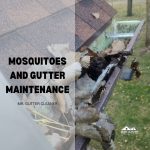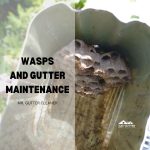Gutter maintenance is a critical component of home maintenance, primarily due to its role in preventing termite infestations. Termites, known for causing significant damage to structures, thrive in environments where moisture is prevalent.
Poorly maintained gutters can create such environments by allowing water to accumulate and seep into the home’s foundation, making it an ideal breeding ground for termites.
Regular inspection and cleaning of gutters are therefore essential in disrupting these conditions.
This process involves not only removing debris that can clog gutters but also identifying and addressing areas susceptible to water accumulation.
Homeowners should be aware of the signs of termite infestation and understand when professional help is needed.
By integrating gutter maintenance into their regular home care routine, they can significantly reduce the risk of termite damage.
This guide provides step-by-step instructions for effective gutter cleaning, tips for safety, and insights into advanced termite prevention strategies, ensuring homeowners are well-equipped to protect their homes.
What Are Termites and How Do They Affect Home Maintenance?
Termites are a pervasive issue in home maintenance due to their destructive habits, particularly targeting wooden structures and materials. These insects feed on cellulose, a component found in wood, leading to severe damage to homes if left unchecked. The presence of termites can degrade the structural integrity of a building, making prompt and effective action crucial.
Understanding Termite Behavior and Habitat
Termites thrive in moist, sheltered environments, often unnoticed until substantial damage occurs. They establish colonies, which can grow to large numbers, within wooden materials or underground. Recognizing the conditions that favor termite habitation is the first step in prevention. These conditions include wood-to-soil contact, excessive moisture, and undisturbed areas such as crawl spaces. By mitigating these conditions, homeowners can significantly reduce the likelihood of termite infestation.
Table Of Contents:
- What Are Termites and How Do They Affect Home Maintenance?
- Why Is Gutter Maintenance Crucial in Preventing Termites?
- How to Inspect Gutters for Termite Prevention
- Comprehensive Gutter Cleaning Techniques
- Professional Gutter Maintenance and Termite Inspection
- Integrating Gutter Maintenance into Regular Home Care
- Advanced Termite Prevention Strategies
- Common Mistakes to Avoid in Termite Prevention
Recognizing the Signs of Termite Infestation
Early detection of termite activity is key to preventing widespread damage. Common signs include wood that sounds hollow when tapped, mud tubes on exterior walls, and visibly damaged or crumbling wood. Additionally, swarms of winged termites or discarded wings near windows and doors can indicate an active colony. Regular inspections around the home for these signs can lead to early intervention and minimize the need for extensive repairs.
Why Is Gutter Maintenance Crucial in Preventing Termites?
Gutter maintenance is vital in home maintenance for preventing termite infestations. Clogged or damaged gutters can lead to water accumulation and dampness around a home’s foundation, creating a conducive environment for termites. Ensuring gutters are clean and well-maintained disrupts this habitat, reducing the likelihood of termite attraction and subsequent damage.
The Role of Gutters in Home Protection
Gutters serve as a critical defense line in protecting a home’s structural integrity by directing water away from the foundation and exterior walls. Functioning gutters prevent water from settling around the base of a home, which not only mitigates the risk of termite infestation but also protects against other forms of damp-related damage. Properly maintained gutters are thus an essential component in a comprehensive home maintenance strategy.
How Poor Gutter Maintenance Attracts Termites
Poor gutter maintenance can lead to blockages and leaks, resulting in water overflow and accumulation around the home. This excess moisture creates an ideal environment for termites, who are attracted to damp, woody areas to establish their colonies. By allowing gutters to fall into disrepair, homeowners inadvertently increase the risk of termites, who can cause extensive and costly damage to wooden structures within the home. Regular cleaning, repairing, and inspection of gutters are therefore imperative in termite prevention.
How to Inspect Gutters for Termite Prevention
Inspecting gutters is a proactive step in preventing termite infestations, essential for maintaining the integrity of a home. Regular, thorough inspections can identify issues that may attract termites, such as moisture buildup and debris accumulation. By addressing these issues promptly, homeowners can significantly reduce the risk of termite infestation.
Step-by-Step Guide to Gutter Inspection
A systematic approach ensures a thorough inspection. Start by ensuring safety measures are in place. Then, examine the gutters for any signs of blockage, damage, or wear. Look for sagging, cracks, or holes that may allow water to accumulate or seep into the structure. Remove any debris, nests, or leaves that can cause clogs and stagnant water. Check the downspouts for blockages and ensure water is directed away from the home’s foundation. It’s also essential to inspect the gutter after severe weather or seasonally when leaves and debris are most likely to accumulate.
Identifying and Addressing Vulnerable Areas
Some areas are more prone to problems than others and require particular attention during inspection. Corners and joints are common points for leaks and clogs. Check for rust or corrosion in metal gutters, as these can lead to holes and cracks. Ensure gutter guards and hangers are secure and functional, as they can help prevent future issues. Pay close attention to the areas around downspouts and the foundation of the house, as water damage in these areas can be particularly conducive to termite infestation. If any issues are identified, prompt repair is crucial to prevent further damage.
Comprehensive Gutter Cleaning Techniques
Effective gutter cleaning is essential in maintaining a home and preventing termite infestations. Comprehensive cleaning removes debris and obstructions, ensuring water flows correctly and does not create moisture-rich environments that attract termites. Utilizing the right techniques and tools is crucial for effective cleaning and long-term gutter maintenance.
Tools and Methods for Effective Cleaning
For thorough cleaning, homeowners should equip themselves with gloves, a ladder, a gutter scoop or garden trowel, and a bucket for debris. Start by removing leaves, twigs, and sediment that have accumulated, working along the gutter’s length. Flush the gutters and downspouts with water to ensure clear passages. For higher or more complex gutter systems, specialized tools such as power washers or gutter cleaning robots can be employed for efficiency and effectiveness. Always prioritize safety by ensuring stable ladder placement and wearing appropriate protective gear.
Safety Tips for DIY Gutter Maintenance
Safety is paramount in DIY gutter maintenance. Always use a sturdy ladder with a stabilizer and never overreach. Wear gloves to protect against sharp objects and debris, and eye protection is advisable when using power tools or during vigorous cleaning. Ensure that the ground below is stable and clear of objects that might pose a tripping hazard. If the house is particularly high or the gutters are difficult to access, consider hiring professionals to avoid the risk of injury.
Professional Gutter Maintenance and Termite Inspection
While DIY efforts are valuable, professional gutter maintenance and termite inspection provide a more thorough approach to preventing termite infestations. Professionals bring expertise, experience, and specialized tools to the task, ensuring that gutters are not only clean but also well-maintained and structurally sound.
When to Call the Professionals
Homeowners should consider professional gutter cleaning services at least twice a year, typically in late spring and early fall, to prevent clogs and potential termite attractants. Additionally, if during a self-inspection, you notice significant damage, persistent clogs, or signs of termite activity, it’s time to call in the experts. Professionals are equipped to handle complex situations, perform repairs, and even recommend improvements to your gutter system.
What to Expect from a Professional Inspection
When professionals arrive, they conduct a thorough inspection of your gutters and the surrounding areas for any signs of damage or vulnerabilities to termite infestation. They clean your gutters, removing all debris and obstructions, and ensure proper water flow. They might also perform minor repairs or suggest preventative measures like gutter guards. Additionally, many gutter maintenance services can provide or recommend termite inspection and treatment, offering a comprehensive approach to protecting your home from these pests.
Integrating Gutter Maintenance into Regular Home Care
Incorporating gutter maintenance into regular home care routines is essential for sustaining the home’s structural integrity and avoiding termite infestations. Consistent upkeep helps prevent the accumulation of debris and water, deterring termite colonies and other pest invasions. Regular maintenance not only extends the life of your gutters but also maintains the aesthetic and health of your home environment.
Creating a Gutter Maintenance Schedule
Homeowners should establish a gutter maintenance schedule that aligns with seasonal changes and specific regional needs. Generally, gutters should be cleaned and inspected at least twice a year: once in the late spring and once in early fall. Additional cleanings may be necessary if your home is under or near trees that shed heavily or in areas prone to frequent storms. Marking these tasks in a home maintenance calendar can serve as a reminder to perform or schedule these essential tasks.
Long-Term Benefits of Regular Maintenance
Regular gutter maintenance offers numerous long-term benefits. Firstly, it prevents costly damage caused by water leaks and termite infestations. Efficiently functioning gutters also protect landscaping, basements, and foundations from water-related issues. Additionally, maintaining gutters in good condition enhances the overall curb appeal of your home and can contribute to its value. Over time, the consistency of care ensures that small issues are addressed before they escalate into major problems, ultimately saving time and resources.
Advanced Termite Prevention Strategies
Beyond regular gutter maintenance, adopting advanced termite prevention strategies is crucial for homeowners seeking to protect their property comprehensively. These strategies involve a combination of physical barriers, chemical treatments, and environmental adjustments to create a multi-layered defense against termite infestation.
Beyond Gutter Maintenance: Additional Measures
To enhance termite prevention, homeowners can adopt additional measures such as installing termite barriers during construction or renovation. These physical barriers are designed to deter termites from accessing the wood structures of a home. Regularly applying termiticides around the perimeter of the home can also create a chemical barrier that termites cannot cross. Additionally, maintaining a dry and well-ventilated environment, especially in crawl spaces, basements, and attics, reduces the moisture that termites seek.
Latest Trends and Technologies in Termite Prevention
The field of termite prevention is continuously evolving, with new and improved methods being developed. Innovations include bait systems that attract and poison termite colonies, as well as biological controls that use natural termite predators. Homeowners can also benefit from new detection technologies that identify termite presence early, preventing widespread damage. Staying informed about these advancements and consulting with pest control professionals can help homeowners choose the most effective and sustainable termite prevention methods.
Common Mistakes to Avoid in Termite Prevention
Effective termite prevention requires not just doing the right things but also avoiding common pitfalls. Many homeowners unintentionally invite termites through simple oversights or misconceptions. Understanding and rectifying these mistakes can significantly enhance the effectiveness of termite prevention measures.
Misconceptions About Gutter Maintenance and Termite Infestation
One common misconception is that gutter maintenance is only necessary for preventing water damage, underestimating its role in termite prevention. Neglecting gutter cleaning leads to moisture accumulation, which attracts termites. Homeowners might also wrongly assume that a visibly clean gutter is a fully functional one, ignoring the need for regular inspections and overlooking hidden blockages or damages that could lead to moisture problems.
Correcting Common Errors in Termite Prevention
Avoiding termite attraction requires more than just gutter maintenance. It includes addressing other moisture sources like leaky faucets, improper drainage, and poor ventilation, especially in basements and attics. Homeowners should also avoid using mulch or storing wood near the home’s foundation, as these can be inviting for termites. Regularly inspecting the home for signs of termites and seeking professional assessments can prevent small issues from becoming significant infestations.


